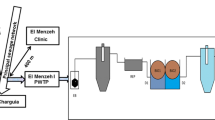Abstract
The transmission and scanning electron microscopes were employed to visualize the sequence of the biofilm development in the trickling wastewater filter. After the deposit of a small amount of debris upon a hard surface, the bacterial cells attach and develop the matrix on which the biofilm is formed. Protozoa invade the basic layer where they feed on the bacteria. The algae are seeded upon the bacterial matrix and grow so profusely that the bacteria must develop aerial colonies in the competition for food and oxygen. Destruction of the bacteria in the matrix and the weight and hydraulic pressure cause detachment of the biofilm and a new matrix must be developed.
Similar content being viewed by others
References
Butterfield, C. T., and E. Wattie. 1941. Studies of sewage purification. XV Effective bacteria in purification by trickling filter.Pub. Health Rep. 56: 2445–2464.
Cooke, W. B., and A. Hirsch. 1958. Continuous sampling of trickling filter populations. II Populations.Sewage and Ind. Wastes 30: 138–156.
Cooke, W. B. 1959. Trickling filter ecology.Ecology 40: 273–291.
Corpe, W. A. 1970. An acid polysaccharide produced by a primary film-forming marine bacterium. Developments Industrial Microbiology.Amer. Inst. Biol. Sci. 11: 402–412.
Crisp, D. J., and J. S. Ryland. 1960. Influence of filming and of surface texture on the settlement of marine organisms.Nature (London) 185: 119.
Hoehn, R. C., and A. D. Ray. 1973. Effects of thickness on bacterial film.J. Water Poll. Control Fed. 45: 2302–2320.
Miller, M. A., J. C. Rapean, and W. F. Whedon. 1948. The role of slime film in the attachment of fouling organisms.Biol. Bull. Woods Hole 94: 143.
Wattie, E. 1942. Culture characteristics of zooglea-forming bacteria isolated from activated sludge and trickling filters.Pub. Health Rep. 57: 1519–1534.
Wood, E. J. F. 1967. Microbiology of Oceans and Estuaries. Elsevier Oceanography Series, Vol. 3. Elsevier Publishing Co., New York, Chapter VIII, pp. 206–225.
ZoBell, C. E. 1939. Fouling of submerged surfaces and possible preventive procedures. The biological approach to the preparation of antifouling paints.Paint, Oil and Chem. Rev. 101: 74–77.
ZoBell, C. E. 1943. The effect of solid surfaces upon bacterial activity.J. Bacteriol. 46: 39–56.
Author information
Authors and Affiliations
Rights and permissions
About this article
Cite this article
Mack, W.N., Mack, J.P. & Ackerson, A.O. Microbial film development in a trickling filter. Microb Ecol 2, 215–226 (1975). https://doi.org/10.1007/BF02010441
Issue Date:
DOI: https://doi.org/10.1007/BF02010441




